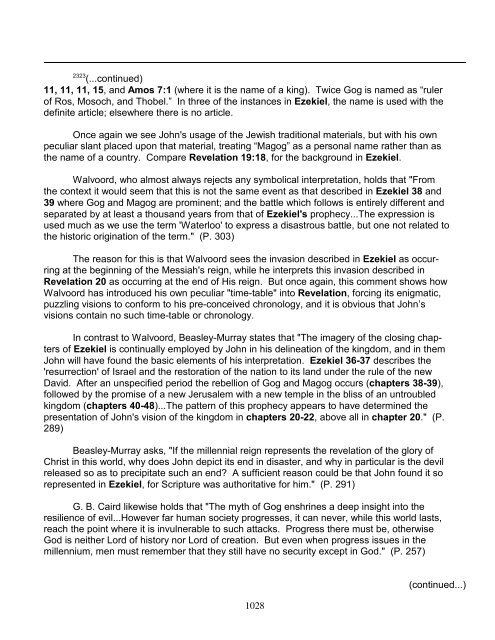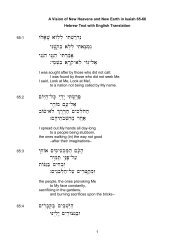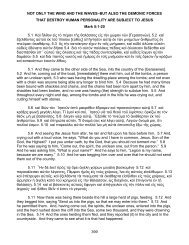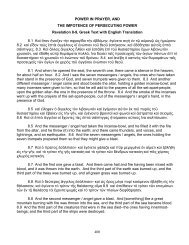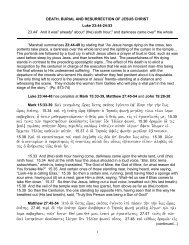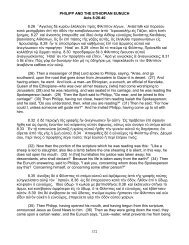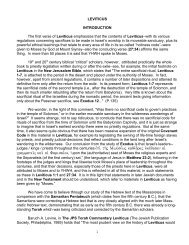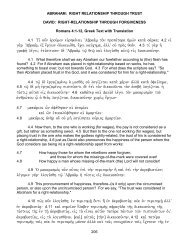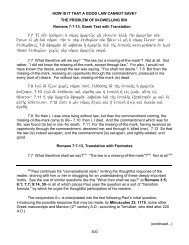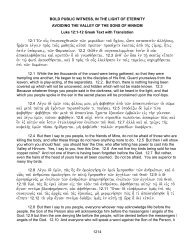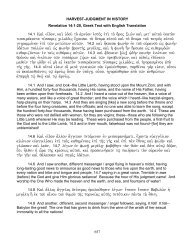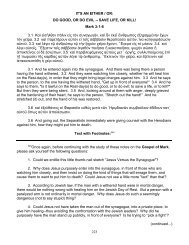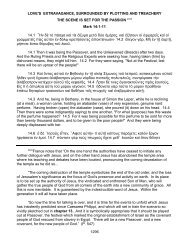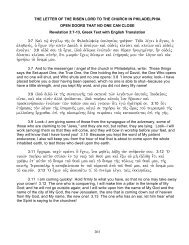Revelation 20 - In Depth Bible Commentaries
Revelation 20 - In Depth Bible Commentaries
Revelation 20 - In Depth Bible Commentaries
Create successful ePaper yourself
Turn your PDF publications into a flip-book with our unique Google optimized e-Paper software.
2323<br />
(...continued)<br />
11, 11, 11, 15, and Amos 7:1 (where it is the name of a king). Twice Gog is named as “ruler<br />
of Ros, Mosoch, and Thobel.” <strong>In</strong> three of the instances in Ezekiel, the name is used with the<br />
definite article; elsewhere there is no article.<br />
Once again we see John's usage of the Jewish traditional materials, but with his own<br />
peculiar slant placed upon that material, treating “Magog” as a personal name rather than as<br />
the name of a country. Compare <strong>Revelation</strong> 19:18, for the background in Ezekiel.<br />
Walvoord, who almost always rejects any symbolical interpretation, holds that "From<br />
the context it would seem that this is not the same event as that described in Ezekiel 38 and<br />
39 where Gog and Magog are prominent; and the battle which follows is entirely different and<br />
separated by at least a thousand years from that of Ezekiel's prophecy...The expression is<br />
used much as we use the term 'Waterloo' to express a disastrous battle, but one not related to<br />
the historic origination of the term." (P. 303)<br />
The reason for this is that Walvoord sees the invasion described in Ezekiel as occurring<br />
at the beginning of the Messiah's reign, while he interprets this invasion described in<br />
<strong>Revelation</strong> <strong>20</strong> as occurring at the end of His reign. But once again, this comment shows how<br />
Walvoord has introduced his own peculiar "time-table" into <strong>Revelation</strong>, forcing its enigmatic,<br />
puzzling visions to conform to his pre-conceived chronology, and it is obvious that John’s<br />
visions contain no such time-table or chronology.<br />
<strong>In</strong> contrast to Walvoord, Beasley-Murray states that "The imagery of the closing chapters<br />
of Ezekiel is continually employed by John in his delineation of the kingdom, and in them<br />
John will have found the basic elements of his interpretation. Ezekiel 36-37 describes the<br />
'resurrection' of Israel and the restoration of the nation to its land under the rule of the new<br />
David. After an unspecified period the rebellion of Gog and Magog occurs (chapters 38-39),<br />
followed by the promise of a new Jerusalem with a new temple in the bliss of an untroubled<br />
kingdom (chapters 40-48)...The pattern of this prophecy appears to have determined the<br />
presentation of John's vision of the kingdom in chapters <strong>20</strong>-22, above all in chapter <strong>20</strong>." (P.<br />
289)<br />
Beasley-Murray asks, "If the millennial reign represents the revelation of the glory of<br />
Christ in this world, why does John depict its end in disaster, and why in particular is the devil<br />
released so as to precipitate such an end? A sufficient reason could be that John found it so<br />
represented in Ezekiel, for Scripture was authoritative for him." (P. 291)<br />
G. B. Caird likewise holds that "The myth of Gog enshrines a deep insight into the<br />
resilience of evil...However far human society progresses, it can never, while this world lasts,<br />
reach the point where it is invulnerable to such attacks. Progress there must be, otherwise<br />
God is neither Lord of history nor Lord of creation. But even when progress issues in the<br />
millennium, men must remember that they still have no security except in God." (P. 257)<br />
1028<br />
(continued...)


